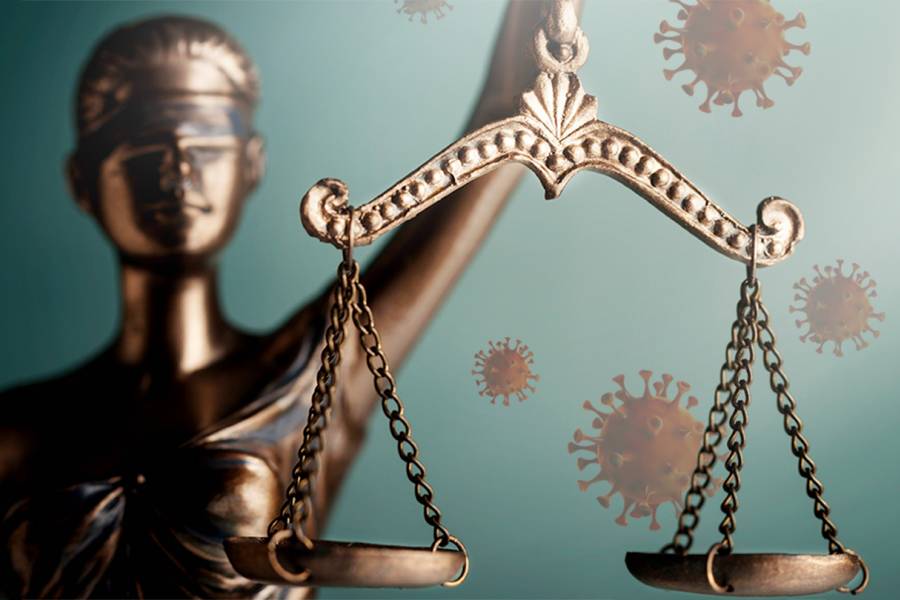In late March, two inmates at Chicago's Cook County jail were placed in isolation after testing positive for COVID-19. Within two weeks, more than 350 inmates and staff members had contracted the virus. By late April, The New York Times had named the facility a "top hot spot," noting that the grim statistics likely didn't reflect the full extent of the problem, since a vast majority of the jail's 4,500 inmates had not been tested.
But the implications of the outbreak went far beyond the carceral facility's gates—one study published April 19 estimates that about 16% of all cases in Chicago were associated with people cycling through Cook County jail.
"There is a belief that is quite common—a misconception—that prisons and jails are somehow separated from communities," explains Chris Beyrer, director of the Center for Public Health and Human Rights within the Bloomberg School of Public Health. "But the fact of the matter is that these places have large staffs. There are usually at least three eight-hour shifts a day, and people are constantly moving in and out of these facilities."
COVID-19 and the U.S. Criminal Justice System: Evidence for Public Health Measures to Reduce Risk, a report published Thursday by the Bloomberg School's Center for Health Security and the Center for Public Health and Human Rights, pulls into view the complicated web of risk factors at play within prisons, jails, and other correctional facilities that make them potential superspreaders of COVID-19. Prepared for the National Commission on COVID-19 and Criminal Justice, the report urges the U.S. criminal justice system to take urgent and swift action to reduce crowding, increase testing, and prevent the spread of infectious disease.
"The lack of preparation—the lack of a public health system—that exists in these facilities is really concerning," says Crystal Watson, co-author of the report and senior scholar within the Center for Health Security. "I hope that not only can we address this during the COVID-19 pandemic, but we can make some systemic changes going forward to make these facilities safer and to be more judicious when we're incarcerating people."
The report lists a slew of interwoven factors that explain why so many of the largest clusters of COVID-19 cases in the U.S. have been in correctional facilities. First, carceral facilities are often overcrowded, making physical distancing and medical isolation difficult. Then, there's the movement of staff in and out of facilities, carrying with them potential infection. There's inconsistent access to personal protective equipment, such as face masks, and hygiene supplies, such as soap or hand sanitizer. "Actually," notes Beyrer, a co-author of the report, "hand sanitizer is contraband in many prisons and jails because it contains alcohol." And there's no standard across the justice system for health care, testing, or reporting related to coronavirus.
The risk of severe infection or death is compounded by an aging prison population with a high rate of comorbidities, according to the report.
As of June 6, the case rate of COVID-19 in prisons was 5.5 times higher than it is among the overall U.S. population. More than 233,000 people in American prisons and jails have been infected to date, and at least 1,372 inmates and correctional officers have died, according to The New York Times.
"People were sounding the alarm back in March and April that this would be a problem, and obviously that has come to fruition," Watson says. "Some steps have been taken, but overall the response is still really subpar."
Beyrer agrees, saying, "We basically lost the entire early ground game that could have saved a lot of lives and prevented a lot of infections."
The report outlines eight key recommendations for jails, prisons, and detention centers to reduce infection rates:
- Reduce population density. Do not detain people for unpaid fees, insufficient bail funds, or parole/probation violations. Consider early release for older individuals and those with chronic conditions.
- Consider health when making decisions related to bail, sentencing, and release.
- Make coronavirus testing data and prevention strategies public.
- Conduct widespread, ongoing coronavirus testing, including antibody tests to get a baseline understanding of the infection rate to date.
- Implement quarantine and medical isolation strategies, making sure they are not equivalent to solitary confinement, which is seen as harmful to physical and mental health.
- Modify facility practices and procedures to prevent infection. Promote physical distancing, improve cleaning practices, make available soap and hand sanitizer, move activities outdoors when possible, and provide surgical masks.
- Standardize health care services across the justice system to ensure access to COVID-19 care.
- When a vaccine becomes available, prioritize incarcerated individuals and staff at the same level as nursing homes.
Also see
The report also lays out recommendations for preventing infection in courthouses, including moving trials and hearings to a virtual setting when possible, promoting physical distancing, and providing masks for staff, defendants, and juries.
For all of its destruction, Beyrer says, the pandemic has provided a unique opportunity to reimagine the criminal justice system in the U.S., which boasts the highest incarceration rate in the world.
"COVID-19 is one of the great crises that has taught us a lot about so many things," he says. "It has revealed, for example, the digital divide in children's education. It has underscored the fact that so many white-collar people can telecommute and work from home, as I have been doing, and that the working poor don't have that option. And I think these prison outbreaks have been similar in some ways. This should really raise our consciousness overall of why a country that bases its identity on loving freedom should be the world's great incarcerator. This is a real opportunity for recalibration."
Posted in Politics+Society
Tagged public health, epidemiology, infectious disease, criminal justice, social justice, racial justice, coronavirus, prison reform








